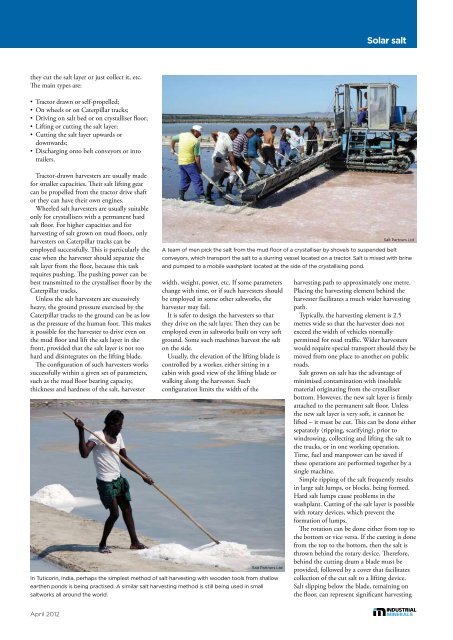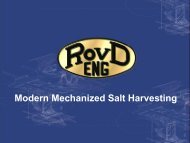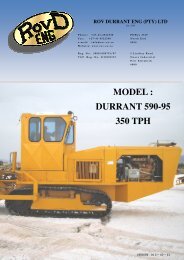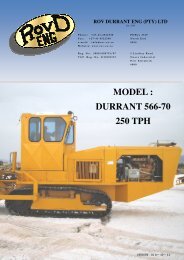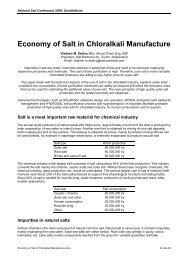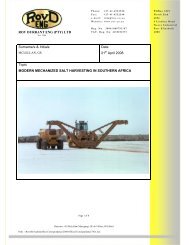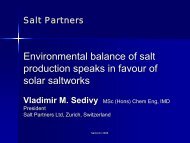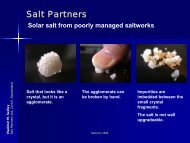Sunny times for solar salt
Sunny times for solar salt.pdf - ResearchGate
Sunny times for solar salt.pdf - ResearchGate
- No tags were found...
Create successful ePaper yourself
Turn your PDF publications into a flip-book with our unique Google optimized e-Paper software.
Solar <strong>salt</strong><br />
they cut the <strong>salt</strong> layer or just collect it, etc.<br />
The main types are:<br />
• Tractor drawn or self-propelled;<br />
• On wheels or on Caterpillar tracks;<br />
• Driving on <strong>salt</strong> bed or on crystalliser floor;<br />
• Lifting or cutting the <strong>salt</strong> layer;<br />
• Cutting the <strong>salt</strong> layer upwards or<br />
downwards;<br />
• Discharging onto belt conveyors or into<br />
trailers.<br />
Tractor-drawn harvesters are usually made<br />
<strong>for</strong> smaller capacities. Their <strong>salt</strong> lifting gear<br />
can be propelled from the tractor drive shaft<br />
or they can have their own engines.<br />
Wheeled <strong>salt</strong> harvesters are usually suitable<br />
only <strong>for</strong> crystallisers with a permanent hard<br />
<strong>salt</strong> floor. For higher capacities and <strong>for</strong><br />
harvesting of <strong>salt</strong> grown on mud floors, only<br />
harvesters on Caterpillar tracks can be<br />
employed successfully. This is particularly the<br />
case when the harvester should separate the<br />
<strong>salt</strong> layer from the floor, because this task<br />
requires pushing. The pushing power can be<br />
best transmitted to the crystalliser floor by the<br />
Caterpillar tracks.<br />
Unless the <strong>salt</strong> harvesters are excessively<br />
heavy, the ground pressure exercised by the<br />
Caterpillar tracks to the ground can be as low<br />
as the pressure of the human foot. This makes<br />
it possible <strong>for</strong> the harvester to drive even on<br />
the mud floor and lift the <strong>salt</strong> layer in the<br />
front, provided that the <strong>salt</strong> layer is not too<br />
hard and disintegrates on the lifting blade.<br />
The configuration of such harvesters works<br />
successfully within a given set of parameters,<br />
such as the mud floor bearing capacity,<br />
thickness and hardness of the <strong>salt</strong>, harvester<br />
width, weight, power, etc. If some parameters<br />
change with time, or if such harvesters should<br />
be employed in some other <strong>salt</strong>works, the<br />
harvester may fail.<br />
It is safer to design the harvesters so that<br />
they drive on the <strong>salt</strong> layer. Then they can be<br />
employed even in <strong>salt</strong>works built on very soft<br />
ground. Some such machines harvest the <strong>salt</strong><br />
on the side.<br />
Usually, the elevation of the lifting blade is<br />
controlled by a worker, either sitting in a<br />
cabin with good view of the lifting blade or<br />
walking along the harvester. Such<br />
configuration limits the width of the<br />
In Tuticorin, India, perhaps the simplest method of <strong>salt</strong> harvesting with wooden tools from shallow<br />
earthen ponds is being practised. A similar <strong>salt</strong> harvesting method is still being used in small<br />
<strong>salt</strong>works all around the world.<br />
A team of men pick the <strong>salt</strong> from the mud floor of a crystalliser by shovels to suspended belt<br />
conveyors, which transport the <strong>salt</strong> to a slurring vessel located on a tractor. Salt is mixed with brine<br />
and pumped to a mobile washplant located at the side of the crystallising pond.<br />
Salt Partners Ltd<br />
Salt Partners Ltd<br />
harvesting path to approximately one metre.<br />
Placing the harvesting element behind the<br />
harvester facilitates a much wider harvesting<br />
path.<br />
Typically, the harvesting element is 2.5<br />
metres wide so that the harvester does not<br />
exceed the width of vehicles normally<br />
permitted <strong>for</strong> road traffic. Wider harvesters<br />
would require special transport should they be<br />
moved from one place to another on public<br />
roads.<br />
Salt grown on <strong>salt</strong> has the advantage of<br />
minimised contamination with insoluble<br />
material originating from the crystalliser<br />
bottom. However, the new <strong>salt</strong> layer is firmly<br />
attached to the permanent <strong>salt</strong> floor. Unless<br />
the new <strong>salt</strong> layer is very soft, it cannot be<br />
lifted – it must be cut. This can be done either<br />
separately (ripping, scarifying), prior to<br />
windrowing, collecting and lifting the <strong>salt</strong> to<br />
the trucks, or in one working operation.<br />
Time, fuel and manpower can be saved if<br />
these operations are per<strong>for</strong>med together by a<br />
single machine.<br />
Simple ripping of the <strong>salt</strong> frequently results<br />
in large <strong>salt</strong> lumps, or blocks, being <strong>for</strong>med.<br />
Hard <strong>salt</strong> lumps cause problems in the<br />
washplant. Cutting of the <strong>salt</strong> layer is possible<br />
with rotary devices, which prevent the<br />
<strong>for</strong>mation of lumps.<br />
The rotation can be done either from top to<br />
the bottom or vice versa. If the cutting is done<br />
from the top to the bottom, then the <strong>salt</strong> is<br />
thrown behind the rotary device. There<strong>for</strong>e,<br />
behind the cutting drum a blade must be<br />
provided, followed by a cover that facilitates<br />
collection of the cut <strong>salt</strong> to a lifting device.<br />
Salt slipping below the blade, remaining on<br />
the floor, can represent significant harvesting<br />
April 2012


